Taxation Law: Australian Residency Rules & Income Analysis
VerifiedAdded on 2023/03/31
|9
|964
|438
Report
AI Summary
This report provides a detailed analysis of taxation law, specifically focusing on determining an individual's residency status according to the ITA Act 1936 and examining the net income of a partnership. The report uses several tests, including the resides test, domicile test, and 183-day test, to assess residency. It concludes that, based on the provided information, the individual is not an Australian resident for the specified income year. Furthermore, the report includes calculations for the net income of a partnership and a distribution statement, considering factors like partners' net income and interest on capital. The accompanying video transcript summarizes the key points and legal references used in the analysis.
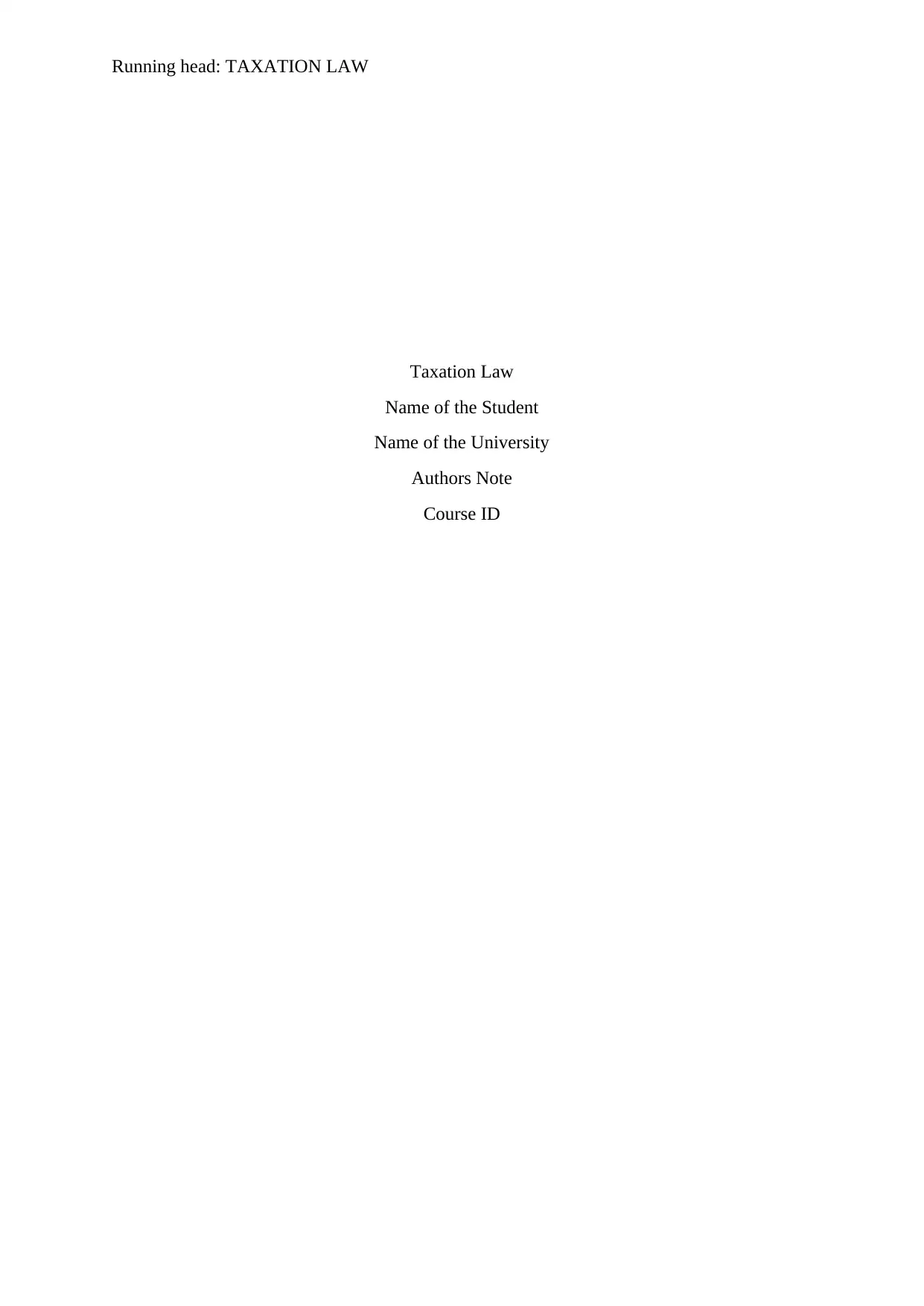
Running head: TAXATION LAW
Taxation Law
Name of the Student
Name of the University
Authors Note
Course ID
Taxation Law
Name of the Student
Name of the University
Authors Note
Course ID
Paraphrase This Document
Need a fresh take? Get an instant paraphrase of this document with our AI Paraphraser
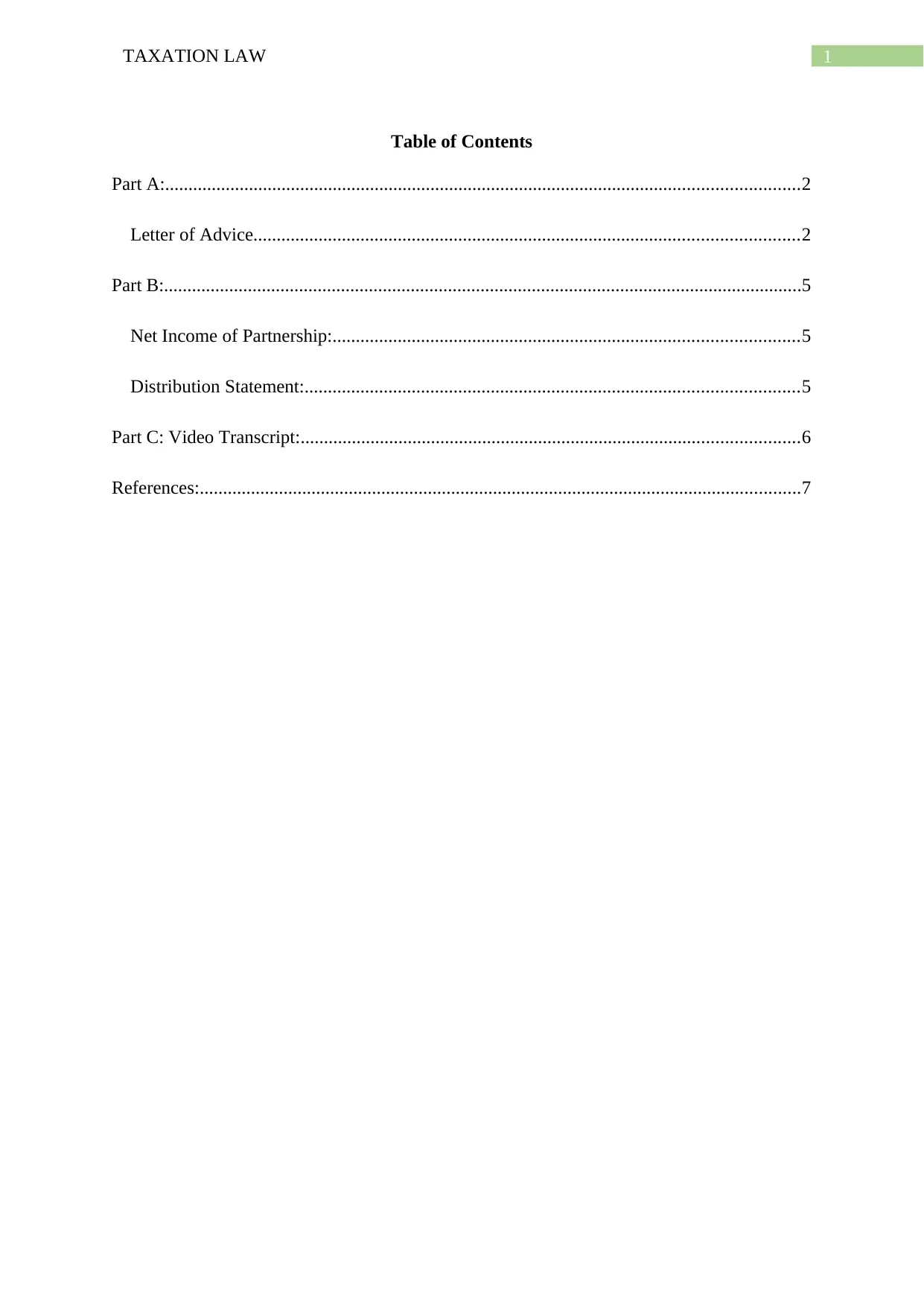
1TAXATION LAW
Table of Contents
Part A:........................................................................................................................................2
Letter of Advice.....................................................................................................................2
Part B:.........................................................................................................................................5
Net Income of Partnership:....................................................................................................5
Distribution Statement:..........................................................................................................5
Part C: Video Transcript:...........................................................................................................6
References:.................................................................................................................................7
Table of Contents
Part A:........................................................................................................................................2
Letter of Advice.....................................................................................................................2
Part B:.........................................................................................................................................5
Net Income of Partnership:....................................................................................................5
Distribution Statement:..........................................................................................................5
Part C: Video Transcript:...........................................................................................................6
References:.................................................................................................................................7
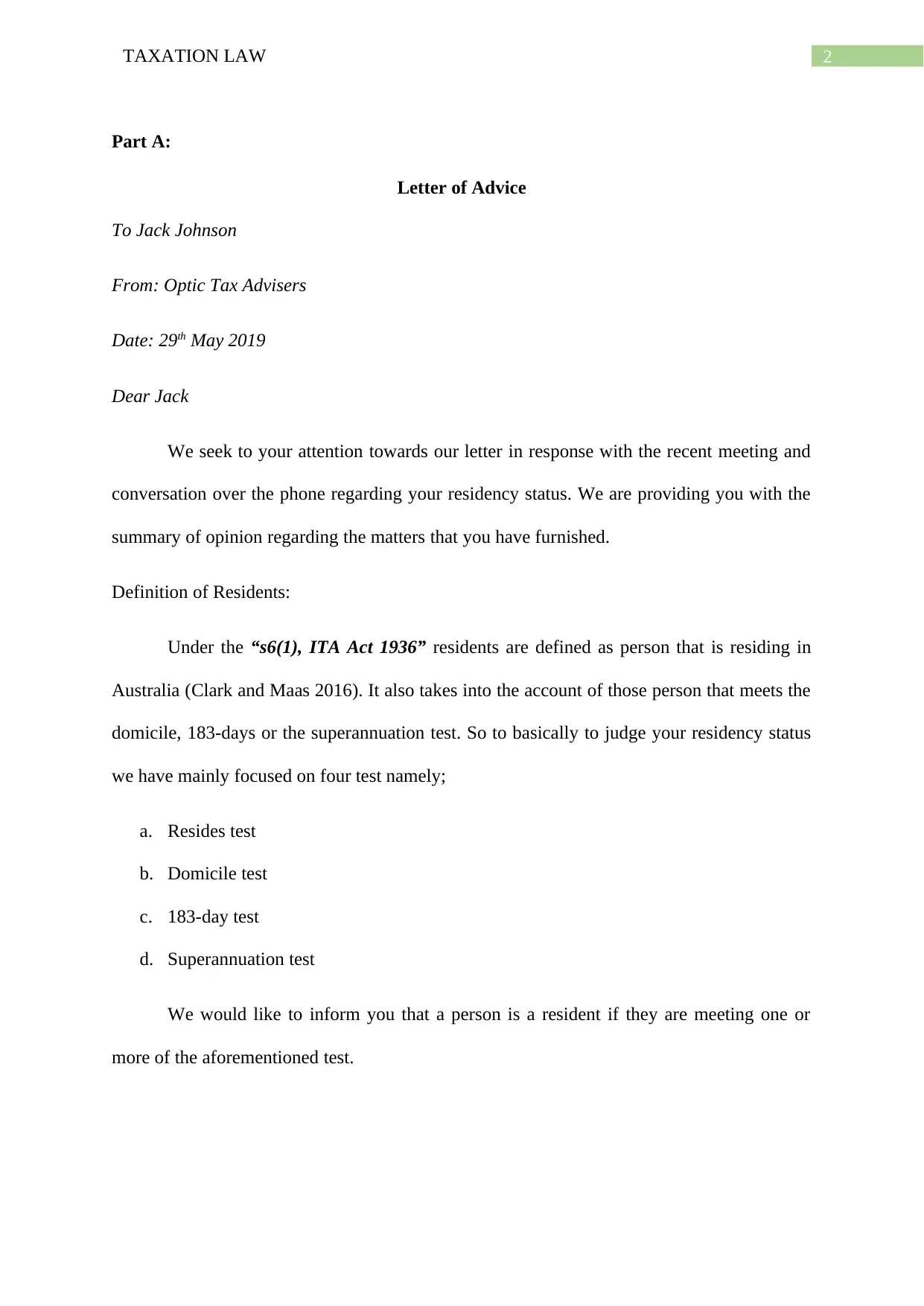
2TAXATION LAW
Part A:
Letter of Advice
To Jack Johnson
From: Optic Tax Advisers
Date: 29th May 2019
Dear Jack
We seek to your attention towards our letter in response with the recent meeting and
conversation over the phone regarding your residency status. We are providing you with the
summary of opinion regarding the matters that you have furnished.
Definition of Residents:
Under the “s6(1), ITA Act 1936” residents are defined as person that is residing in
Australia (Clark and Maas 2016). It also takes into the account of those person that meets the
domicile, 183-days or the superannuation test. So to basically to judge your residency status
we have mainly focused on four test namely;
a. Resides test
b. Domicile test
c. 183-day test
d. Superannuation test
We would like to inform you that a person is a resident if they are meeting one or
more of the aforementioned test.
Part A:
Letter of Advice
To Jack Johnson
From: Optic Tax Advisers
Date: 29th May 2019
Dear Jack
We seek to your attention towards our letter in response with the recent meeting and
conversation over the phone regarding your residency status. We are providing you with the
summary of opinion regarding the matters that you have furnished.
Definition of Residents:
Under the “s6(1), ITA Act 1936” residents are defined as person that is residing in
Australia (Clark and Maas 2016). It also takes into the account of those person that meets the
domicile, 183-days or the superannuation test. So to basically to judge your residency status
we have mainly focused on four test namely;
a. Resides test
b. Domicile test
c. 183-day test
d. Superannuation test
We would like to inform you that a person is a resident if they are meeting one or
more of the aforementioned test.
⊘ This is a preview!⊘
Do you want full access?
Subscribe today to unlock all pages.

Trusted by 1+ million students worldwide
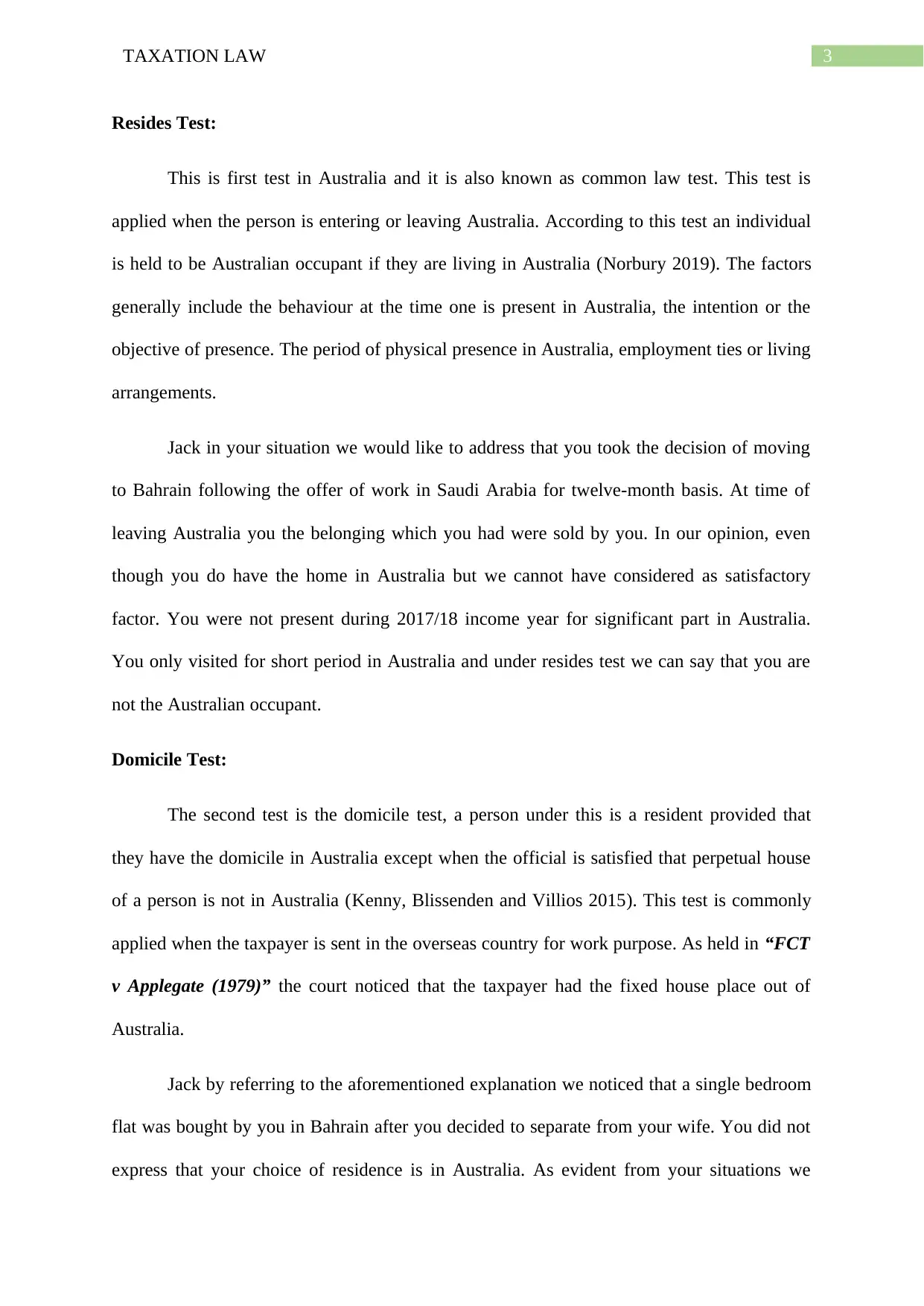
3TAXATION LAW
Resides Test:
This is first test in Australia and it is also known as common law test. This test is
applied when the person is entering or leaving Australia. According to this test an individual
is held to be Australian occupant if they are living in Australia (Norbury 2019). The factors
generally include the behaviour at the time one is present in Australia, the intention or the
objective of presence. The period of physical presence in Australia, employment ties or living
arrangements.
Jack in your situation we would like to address that you took the decision of moving
to Bahrain following the offer of work in Saudi Arabia for twelve-month basis. At time of
leaving Australia you the belonging which you had were sold by you. In our opinion, even
though you do have the home in Australia but we cannot have considered as satisfactory
factor. You were not present during 2017/18 income year for significant part in Australia.
You only visited for short period in Australia and under resides test we can say that you are
not the Australian occupant.
Domicile Test:
The second test is the domicile test, a person under this is a resident provided that
they have the domicile in Australia except when the official is satisfied that perpetual house
of a person is not in Australia (Kenny, Blissenden and Villios 2015). This test is commonly
applied when the taxpayer is sent in the overseas country for work purpose. As held in “FCT
v Applegate (1979)” the court noticed that the taxpayer had the fixed house place out of
Australia.
Jack by referring to the aforementioned explanation we noticed that a single bedroom
flat was bought by you in Bahrain after you decided to separate from your wife. You did not
express that your choice of residence is in Australia. As evident from your situations we
Resides Test:
This is first test in Australia and it is also known as common law test. This test is
applied when the person is entering or leaving Australia. According to this test an individual
is held to be Australian occupant if they are living in Australia (Norbury 2019). The factors
generally include the behaviour at the time one is present in Australia, the intention or the
objective of presence. The period of physical presence in Australia, employment ties or living
arrangements.
Jack in your situation we would like to address that you took the decision of moving
to Bahrain following the offer of work in Saudi Arabia for twelve-month basis. At time of
leaving Australia you the belonging which you had were sold by you. In our opinion, even
though you do have the home in Australia but we cannot have considered as satisfactory
factor. You were not present during 2017/18 income year for significant part in Australia.
You only visited for short period in Australia and under resides test we can say that you are
not the Australian occupant.
Domicile Test:
The second test is the domicile test, a person under this is a resident provided that
they have the domicile in Australia except when the official is satisfied that perpetual house
of a person is not in Australia (Kenny, Blissenden and Villios 2015). This test is commonly
applied when the taxpayer is sent in the overseas country for work purpose. As held in “FCT
v Applegate (1979)” the court noticed that the taxpayer had the fixed house place out of
Australia.
Jack by referring to the aforementioned explanation we noticed that a single bedroom
flat was bought by you in Bahrain after you decided to separate from your wife. You did not
express that your choice of residence is in Australia. As evident from your situations we
Paraphrase This Document
Need a fresh take? Get an instant paraphrase of this document with our AI Paraphraser
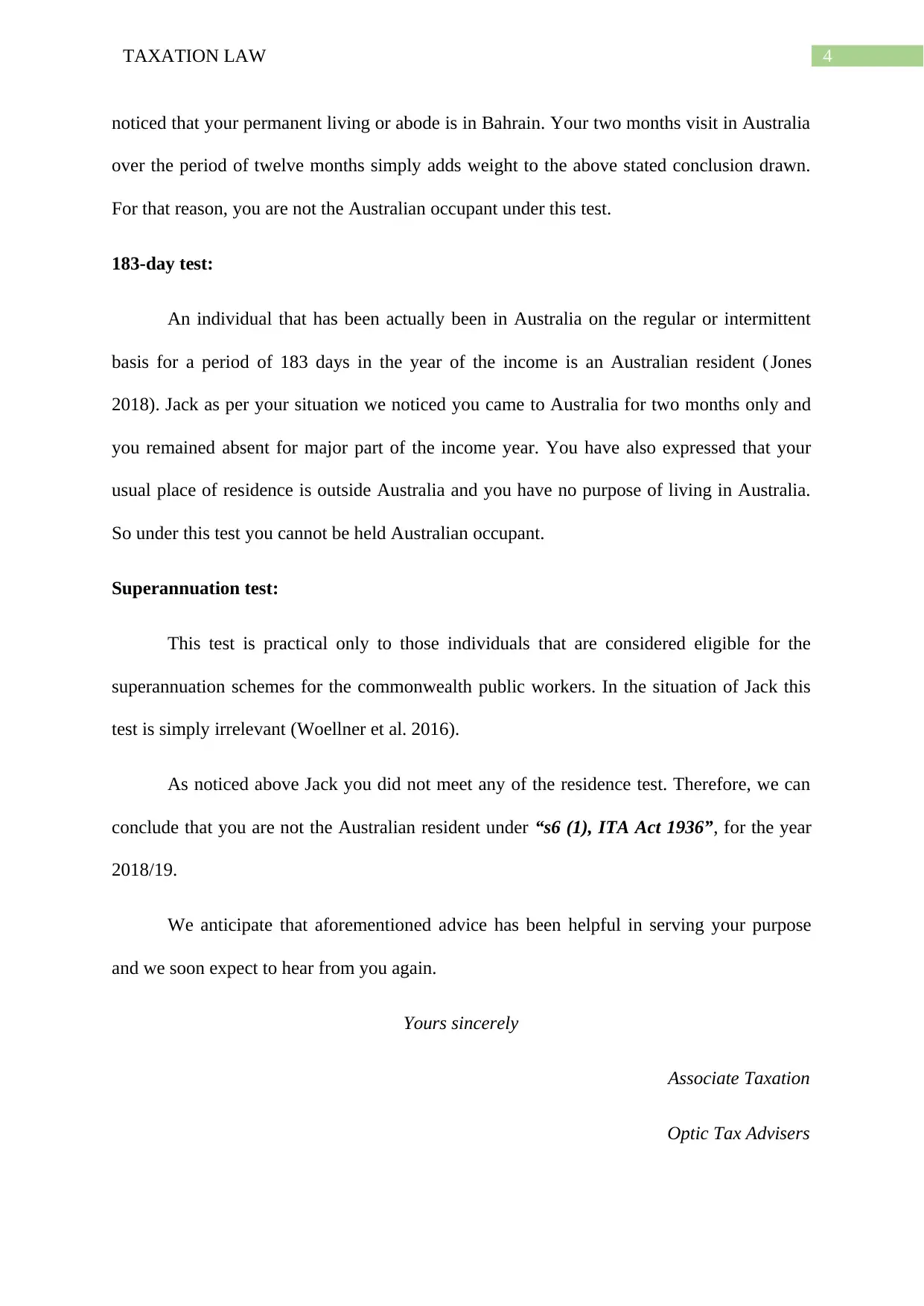
4TAXATION LAW
noticed that your permanent living or abode is in Bahrain. Your two months visit in Australia
over the period of twelve months simply adds weight to the above stated conclusion drawn.
For that reason, you are not the Australian occupant under this test.
183-day test:
An individual that has been actually been in Australia on the regular or intermittent
basis for a period of 183 days in the year of the income is an Australian resident (Jones
2018). Jack as per your situation we noticed you came to Australia for two months only and
you remained absent for major part of the income year. You have also expressed that your
usual place of residence is outside Australia and you have no purpose of living in Australia.
So under this test you cannot be held Australian occupant.
Superannuation test:
This test is practical only to those individuals that are considered eligible for the
superannuation schemes for the commonwealth public workers. In the situation of Jack this
test is simply irrelevant (Woellner et al. 2016).
As noticed above Jack you did not meet any of the residence test. Therefore, we can
conclude that you are not the Australian resident under “s6 (1), ITA Act 1936”, for the year
2018/19.
We anticipate that aforementioned advice has been helpful in serving your purpose
and we soon expect to hear from you again.
Yours sincerely
Associate Taxation
Optic Tax Advisers
noticed that your permanent living or abode is in Bahrain. Your two months visit in Australia
over the period of twelve months simply adds weight to the above stated conclusion drawn.
For that reason, you are not the Australian occupant under this test.
183-day test:
An individual that has been actually been in Australia on the regular or intermittent
basis for a period of 183 days in the year of the income is an Australian resident (Jones
2018). Jack as per your situation we noticed you came to Australia for two months only and
you remained absent for major part of the income year. You have also expressed that your
usual place of residence is outside Australia and you have no purpose of living in Australia.
So under this test you cannot be held Australian occupant.
Superannuation test:
This test is practical only to those individuals that are considered eligible for the
superannuation schemes for the commonwealth public workers. In the situation of Jack this
test is simply irrelevant (Woellner et al. 2016).
As noticed above Jack you did not meet any of the residence test. Therefore, we can
conclude that you are not the Australian resident under “s6 (1), ITA Act 1936”, for the year
2018/19.
We anticipate that aforementioned advice has been helpful in serving your purpose
and we soon expect to hear from you again.
Yours sincerely
Associate Taxation
Optic Tax Advisers

5TAXATION LAW
⊘ This is a preview!⊘
Do you want full access?
Subscribe today to unlock all pages.

Trusted by 1+ million students worldwide
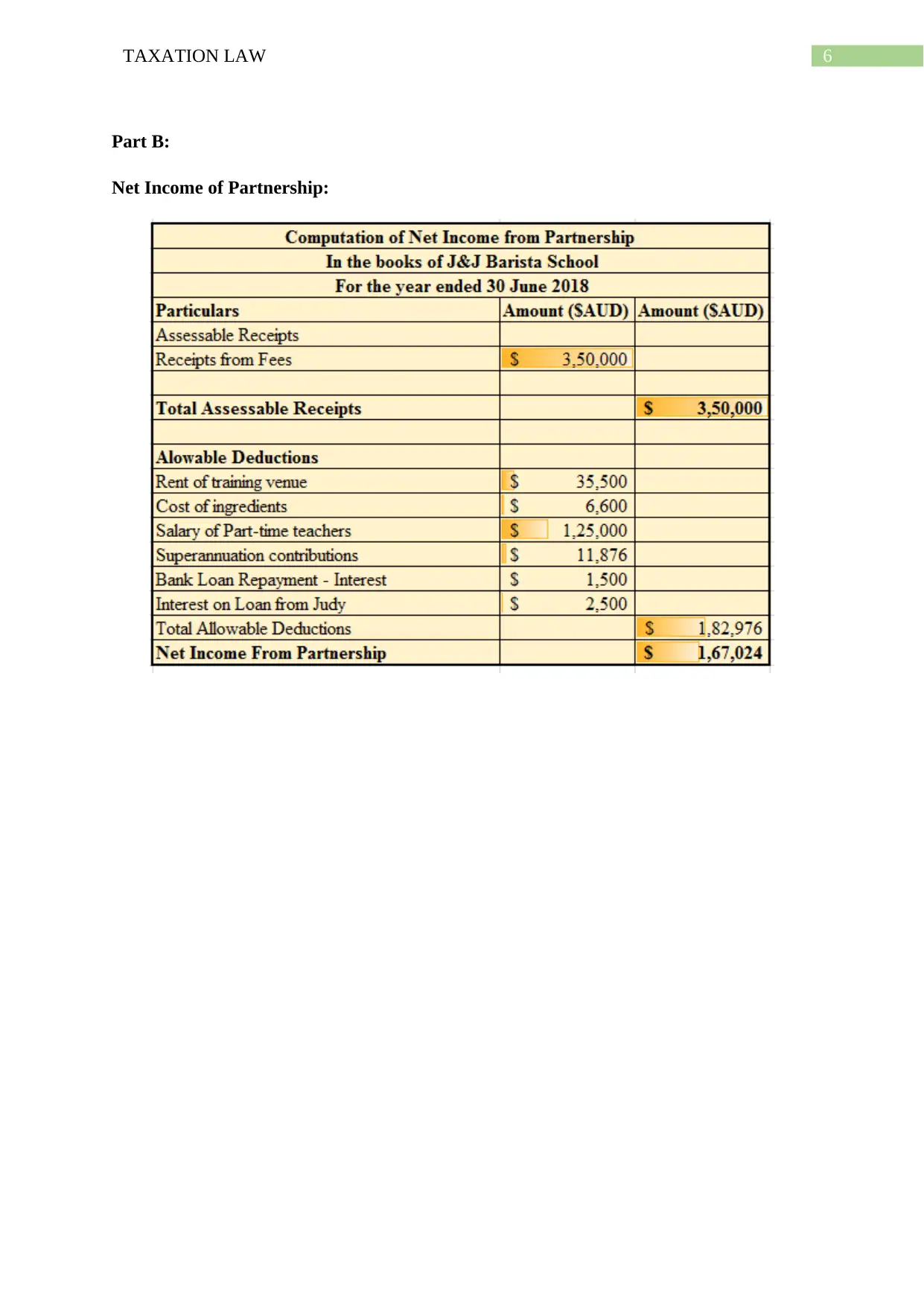
6TAXATION LAW
Part B:
Net Income of Partnership:
Part B:
Net Income of Partnership:
Paraphrase This Document
Need a fresh take? Get an instant paraphrase of this document with our AI Paraphraser
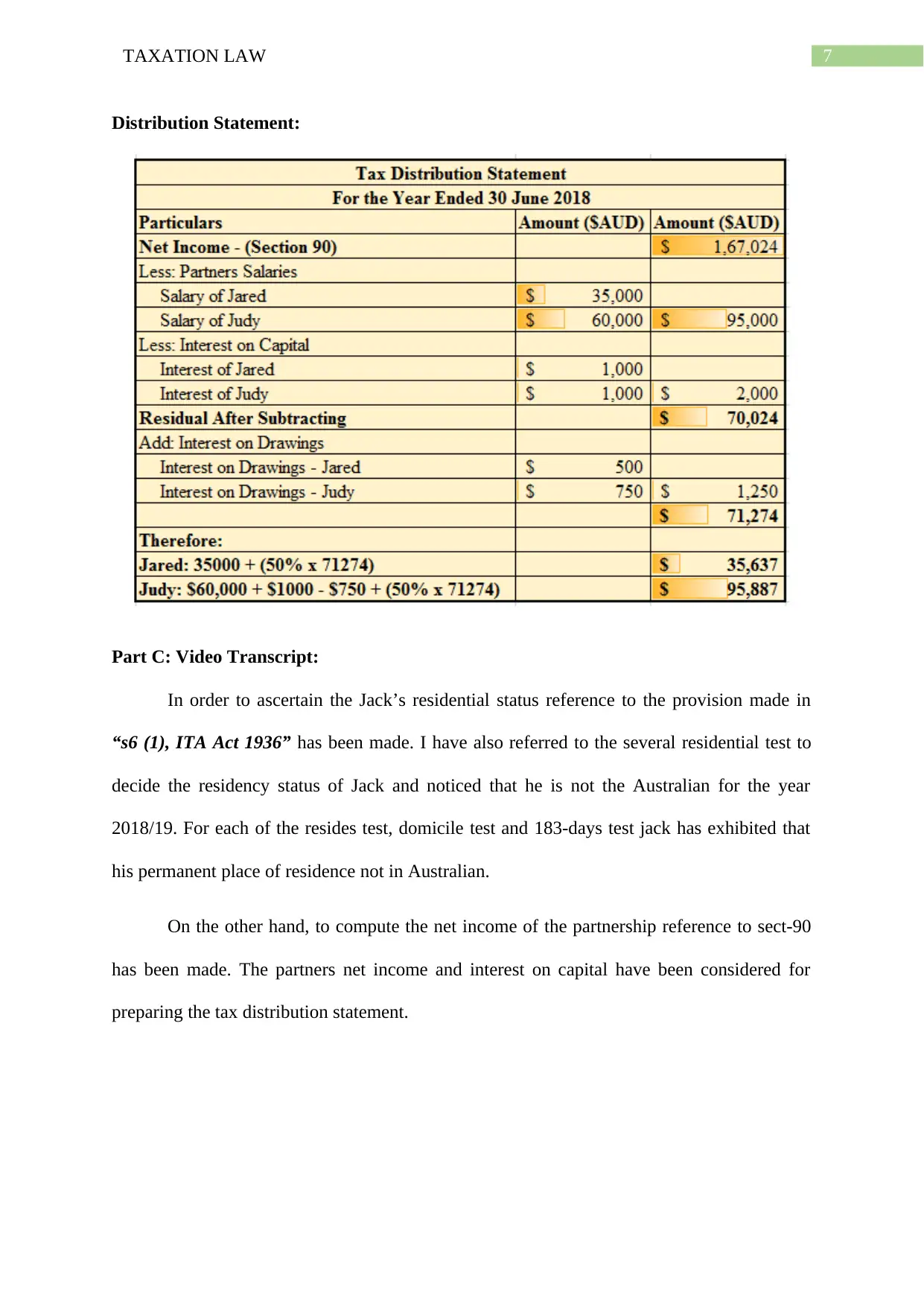
7TAXATION LAW
Distribution Statement:
Part C: Video Transcript:
In order to ascertain the Jack’s residential status reference to the provision made in
“s6 (1), ITA Act 1936” has been made. I have also referred to the several residential test to
decide the residency status of Jack and noticed that he is not the Australian for the year
2018/19. For each of the resides test, domicile test and 183-days test jack has exhibited that
his permanent place of residence not in Australian.
On the other hand, to compute the net income of the partnership reference to sect-90
has been made. The partners net income and interest on capital have been considered for
preparing the tax distribution statement.
Distribution Statement:
Part C: Video Transcript:
In order to ascertain the Jack’s residential status reference to the provision made in
“s6 (1), ITA Act 1936” has been made. I have also referred to the several residential test to
decide the residency status of Jack and noticed that he is not the Australian for the year
2018/19. For each of the resides test, domicile test and 183-days test jack has exhibited that
his permanent place of residence not in Australian.
On the other hand, to compute the net income of the partnership reference to sect-90
has been made. The partners net income and interest on capital have been considered for
preparing the tax distribution statement.
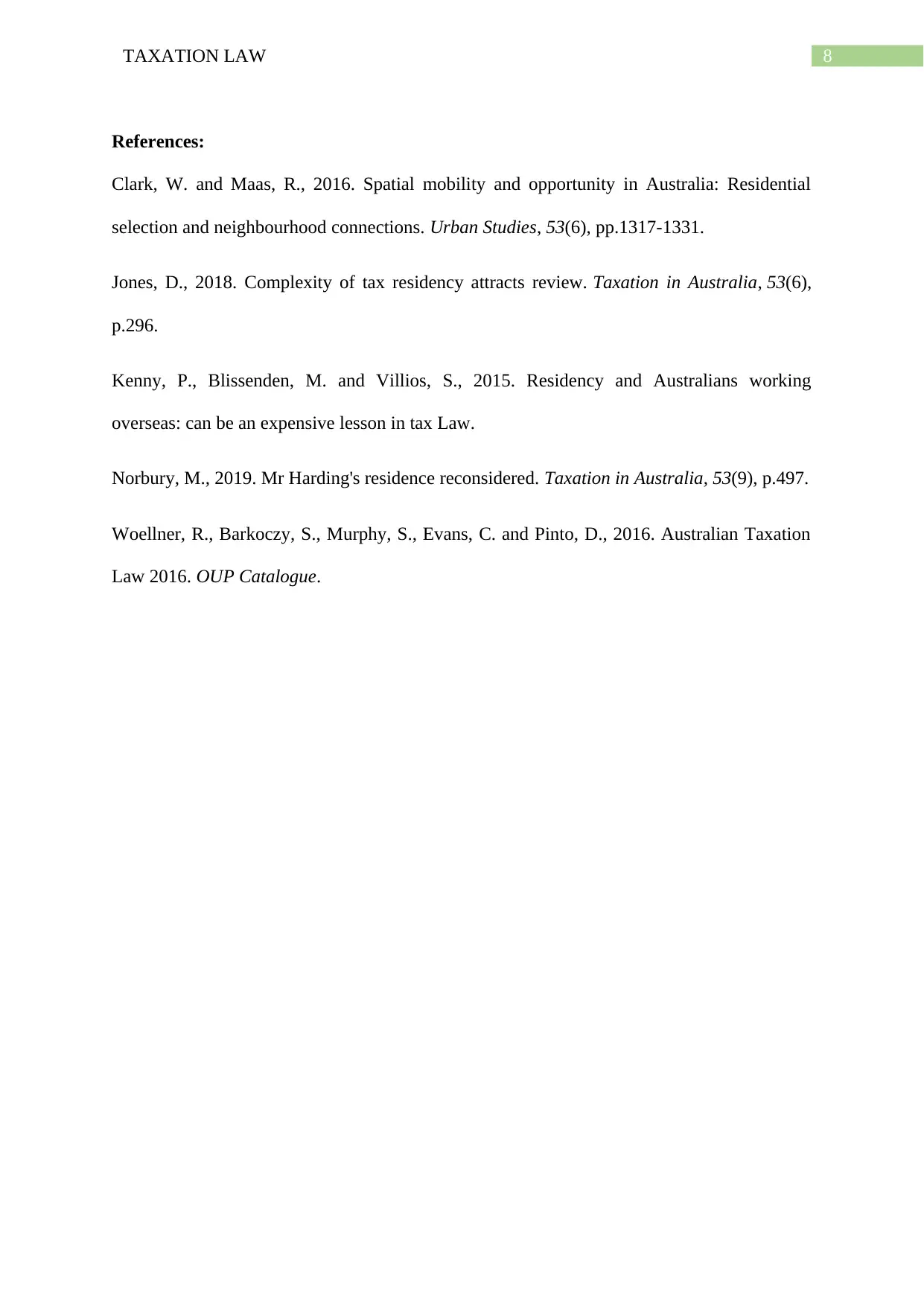
8TAXATION LAW
References:
Clark, W. and Maas, R., 2016. Spatial mobility and opportunity in Australia: Residential
selection and neighbourhood connections. Urban Studies, 53(6), pp.1317-1331.
Jones, D., 2018. Complexity of tax residency attracts review. Taxation in Australia, 53(6),
p.296.
Kenny, P., Blissenden, M. and Villios, S., 2015. Residency and Australians working
overseas: can be an expensive lesson in tax Law.
Norbury, M., 2019. Mr Harding's residence reconsidered. Taxation in Australia, 53(9), p.497.
Woellner, R., Barkoczy, S., Murphy, S., Evans, C. and Pinto, D., 2016. Australian Taxation
Law 2016. OUP Catalogue.
References:
Clark, W. and Maas, R., 2016. Spatial mobility and opportunity in Australia: Residential
selection and neighbourhood connections. Urban Studies, 53(6), pp.1317-1331.
Jones, D., 2018. Complexity of tax residency attracts review. Taxation in Australia, 53(6),
p.296.
Kenny, P., Blissenden, M. and Villios, S., 2015. Residency and Australians working
overseas: can be an expensive lesson in tax Law.
Norbury, M., 2019. Mr Harding's residence reconsidered. Taxation in Australia, 53(9), p.497.
Woellner, R., Barkoczy, S., Murphy, S., Evans, C. and Pinto, D., 2016. Australian Taxation
Law 2016. OUP Catalogue.
⊘ This is a preview!⊘
Do you want full access?
Subscribe today to unlock all pages.

Trusted by 1+ million students worldwide
1 out of 9
Related Documents
Your All-in-One AI-Powered Toolkit for Academic Success.
+13062052269
info@desklib.com
Available 24*7 on WhatsApp / Email
![[object Object]](/_next/static/media/star-bottom.7253800d.svg)
Unlock your academic potential
Copyright © 2020–2025 A2Z Services. All Rights Reserved. Developed and managed by ZUCOL.





